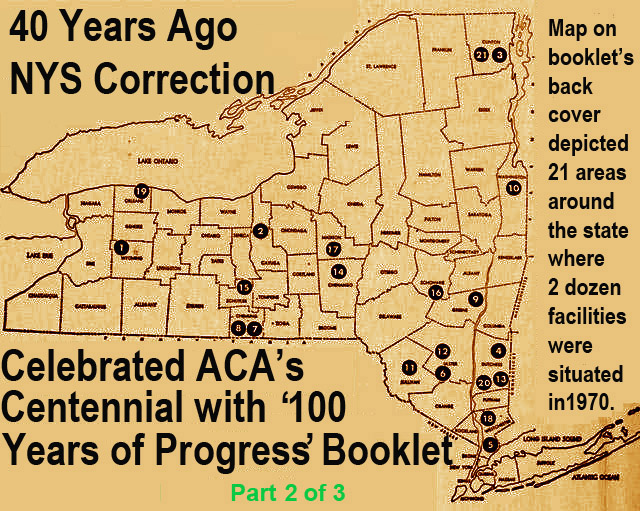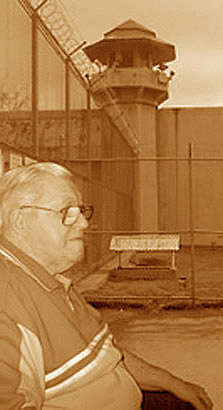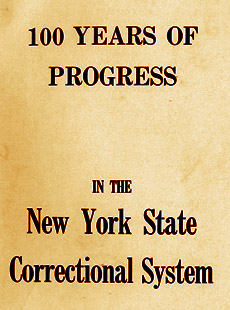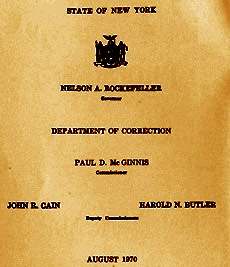

 |
The August 1970 booklet text, Pages 9 through 17: |  Outer & inner front cover. 
|
|
"The poor harassed lone chaplain zealously attempted the work of a dozen departments and as many specialists. .. . He was adviser, social worker . . . . and not least of all, correspondence censor . . . The chaplain in the middle of the century had this work further complicated by having to recopy all inmate outgoing mail. The inmate would write his letter on a state, bring it to the chaplain who would discuss it if necessary, copy, and then mail it. Two days a month he spent in field work, visiting about inmate problems."
As the chaplain's responsibilities have narrowed, however, they have been deepened and intensified, and his qualifications have evoked in the various religious denominations a growing desire to appoint men adequately equipped for this specialized vocation. Pre-service and in-service training have been stepped up; the chaplains' professional organization have developed helpful informational literature, guides and manuals; salaries and operating budgets for chaplains have been improved; increasingly, separate facilities are being made available as chapels which are much more conducive to meaningful and undistracted worship and meditation.... A "Service Unit" is now the central caseworking, case recording and coordinating agency in the correctional facility. As the Department refined and expanded its rehabilitative programs, the service unit has played an increasing role in coordinating the planning, execution and follow-up of this treatment program for each inmate. The major tasks of the service unit include providing counseling and guidance for inmates in institutional and personal matters, assisting inmates to effect community adjustment, and coordinating specialized services and treatment programs for the inmates, such as group counseling, Alcoholics Anonymous and trade licenses. The program is carried out by a professional staff of 66 and an equal complement of clerical workers. Inmate casework interviews during 1969 totaled over 61,000. In the allied area of group counseling, this therapeutic technique and supportive group treatment has been offered in a gradually increasing number of institutions since 1962. During the past year over 4,400 offenders were enrolled in the program. Over the past seven years, 86 lay employee's, most of them correction officers, have been trained as group leaders. Institution psychologists are active in training the leaders and also in conducting counseling sessions of their own.
With regard to prison labor a century ago, one investigator reported:
"Successful contractors moved into the prison with equipment, machines, and all raw materials to operate the industry. They provided their own foreman for technical supervision, though in the early days sometimes convict 'bosses' were employed . . "I have found a system of overwork existing in several of the shops where the convicts are at work on a contract, which is very pernicious to the welfare of the institution. It leads to barter and traffic among the convicts, to an unwarrantable familiarity between convicts and contractor’s agents, to jealousies and dissatisfaction among the prisoners, and to the performance of an amount of labor in many cases greater than the strength and constitution of the men can endure and consequently to a great augmentation of the sick list in the hospital . . . "The system in Sing Sing had no formal or designated beginning; it grew up gradually, and I might say imperceptibly. The contractors received special permits to give the prisoners tobacco, and sometimes medicines. The prisoner, in return, as an act of gratitude, would do work beyond his task. Further permits were afterwards received by the contractors to give the prisoners some little delicacies on holidays. "This stimulated a desire on their part for further indulgence. They would intercede with the contractor’s foremen to bring them various articles of food privately, for which they would pay money which they managed to secrete about their persons when they came to prison, or which they received from friends or relatives. But some prisoners do not have money, or could not do this; consequently they would pay for these things in overwork. The foremen seized on this as a favorable opportunity for making some money by bringing in contraband articles and selling them to convicts at exorbitant prices. The system gradually enlarged its dimensions, until little stores almost were formed inside the prison, which were daily replenished from the village grocers . . . ." A former employee from another prison added during the same investigation: "These contraband articles, I think, usually sold at an advance of not less than 400% . . . ." Contracts affected proper dispersion of population in the three existing prisons. Both Auburn and Sing Sing were usually full. At Sing Sing there were occasions when as many as 500 men were doubled up in the cells. Yet at Clinton in the early days, population was below capacity. The institution was inaccessible at the time, one of the reports of the inspectors stating in the late 1850s that it required forty hours of traveling to reach Clinton from Albany. There was as well, effective opposition to transfer by families of inmates. Yet the major reason for disproportionate population concentration was that policies and regulations provided that inmates could be transferred only if they could be "more profitably" employed at another institution. As there never seemed enough "able bodied" convicts at Sing Sing to carry on existing contract, population remained above capacity despite the existence of empty cells at Clinton. Though the regulations had been changed, the report of the investigation of 1883 indicated that adequate transfers were still not being made for this reason Contractors influenced the amount and type of punishment used. Inmates were required to perform the set task and had to make up "short work" the following day or later if they failed to measure up to the task. Poor work and too little work were the most frequent reasons for punishment. Contractors preferred kinds of punishment that were simple, forceful, and effective. Whacking a man with the paddle chastened him quickly and, besides, kept him absent from the shop for only a very short time.
Today, the "correctional industries" operated by the Department of Correction are financed by the Correctional Industry Fund, which receives all receipts from selling to governmental agencies goods produced by the Industries. The Fund is the source of all expenditures made in connection with the Industries for personal services, payment of inmate wages, purchase of raw materials, supplies, equipment and the construction of industrial buildings. Correctional Industries also helps defray the operating expense of the institutions housing industrial units by the purchase of fuel on a pro-rated basis. The Division of Correctional Industries aims to teach the inmates modern trades and occupations, and to develop skills and good work habits under the same working conditions and production tempos found in private industries. The inmates are placed in a desirable position in the free labor market so that they may legally and gainfully support themselves and their dependents upon their release. For example, since 1966, nine of the ten industrial units have been modernized to meet the above criteria. The tenth operation is rapidly being phased out. New products have been designed and placed in production; outmoded products and programs have been discarded. For example, Attica Correctional Facility operates a mechanized metal products manufacturing plant and tool and die department; Auburn Correctional Facility operates a modern mechanized metal plant and laminated modular furniture plant. Green Haven Correctional Facility replaced its cotton weaving mill with a mechanized library furniture and dormitory equipment plant.
We are meeting the needs of those confined in the male and female facility and are now focusing our attention on the youth camp facilities to provide the younger inmate with much needed industrial experience. The young short-term inmate is a desirable candidate in the free labor market primarily due to his age upon release. He has many productive years ahead before reaching compulsory retirement age, giving him the opportunity to grow with an employer. We are reaching these individuals through joint educational and industrial programs whereby the inmate spends part of his time in school and part of his time in an industrial shop, participating in highly concentrated and accelerated programs. Elmira, Attica, Green Haven, Clinton and Catskill Correctional Facilities are presently operating such joint programs. Long-range plans include the expansion of this program after proper research and evaluation have been conducted in the balance of the institutions. The joint education and industrial program is patterned after successful training programs conducted by many large industrial organizations within the United States designed to meet the need of the hard-core ghetto groups. The Division of Industries has established a working relationship with many free industrial organizations within the State, whereby outside industry will hire paroled or released inmates upon the recommendation of the Division of Industries. This relationship was established by encouraging our industrial counterpart within the State to visit our industrial units in order to determine if training and work experience within our units would properly prepare the inmates for employment within their organizations. The Division of Correctional Industries is a self-supporting organization, providing its financial needs through the sale of its products. The cost of plant modernization and product development is also supported through our earnings, enabling us to continually improve our program by providing proper facilities for inmate training that meets the need of the free labor market.
Year after year it was the same, except by order of the physician, who sometimes changed the breakfast for sick inmates to mush and molasses. The "coffee" was consumed in prodigious quantities, three to four hundred gallons a day. The potion, known as "crust coffee," was made from 15 pounds of coffee, two or two and a half barrels of burned bread crusts and 300 or more gallons of water. At dinner, meat and vegetables were served....
It is well recognized that good food, properly prepared and served, though low in cost, is a prime contributing factor to the well-being and morale of the inmates of correctional institutions. A director of nutritional services gives direction to the Department's efforts to achieve in all of its institutions the objectives of its food service program: continued improvement of quality control, quantity control and cost control. Kitchen and dining facilities and food service equipment are constantly being modernized and improved to reflect changing concepts in institutional feeding.
Predictions of the future are chancy at the best. The best one can do is to point out various trends which seem to be prevalent at the present time, couple these with hopeful expectations and project the result into the future. The differences which seem so great between a century ago and the present have evolved gradually over that 100 year period. At the present time there is great interest in crime, its prevention and cure. The field of corrections appears on the brink of radical changes. However, change is a continuous process and the changes that do come will probably evolve gradually.
Laws have been passed which enabled the Department of Correction to embark on a work release program for selected inmates. In this program, certain inmates are permitted to leave the institution for education, on - the - job training, or for industrial employment. This program is expected to ease the transition from institution life to participation in community living. At the present time this program is underway in only one state institution. If this project is successful, it will be expanded to include several other institutions. The work release program is one of the programs which underlines the present trend toward the greater use of community resources, both public and private, in the correctional field. At the start of next year, the Department of Correction will be combined with the Division of Parole to form the new Department of Correctional Services.
In the future, with the institution of the new department, there will be less and less of a sharp dichotomy between incarceration and parole. Offenders will be able to be moved in and out of institutions under varying degrees of restraint and with greater ease. There will be more of a blending of the institutional rehabilitative programs and the educational and training resources in the community. Work release programs, weekend sentences, halfway houses and similar community based programs will become more common and more varied. The trend nowadays is toward smaller specialized facilities which treat particular classes of inmates. The institutions in the future will be smaller and located nearer areas which will offer greater opportunities for education and training. The Department of Correction is in the process of converting the Ossining Correctional Facility, which was formerly known as Sing Sing, into a reception center for adult male offenders.
It will then receive, study and diagnose all adult male offenders in order to prescribe a planned program of control and treatment for the improvement of their attitudes, aptitudes and behavior. On the basis of the testing and diagnosis at the Reception Center, the offender will be assigned to a particular institution and program which will fulfill his needs. At the present, the adult male offenders are received in several institutions. The change when completed will enable the Department to maxmize the reception process. A recent law change which has significant implications in the correction field permits the courts to impose sentences of intermittent imprisonment for offenses which are punishable by a sentence of up to one year in jail. This type of sentence will permit some offenders to stay employed and maintain their family and community contacts when serving their sentence in an institution on weekends or other selected times.
In the future, if the system is expanded, it could materially aid program directors in the evaluation and control of their programs. This system could also be extended to bring the institutions into closer linkage with the Main Office. The Department is currently engaged in a major research project to make a scientific assessment of our efforts to rehabilitate the offender. The focus of the study is the young male offenders who passed through the Reception Center over a 20-year period. This study will provide an analysis of the information on recidivism, and also some evidence on the current theories of treatment. The results of this project should influence the rehabilitative program of the Department for years to come.
In the coming years as new and better techniques become available to treat the problem of crime and recidivism, they will be incorporated in our program so that the New York Correctional system will remain in the forefront of the correctional field. |

|

|

|